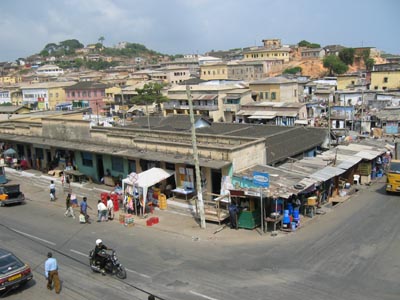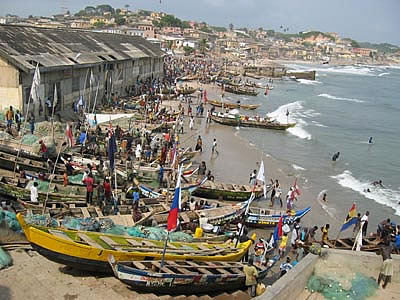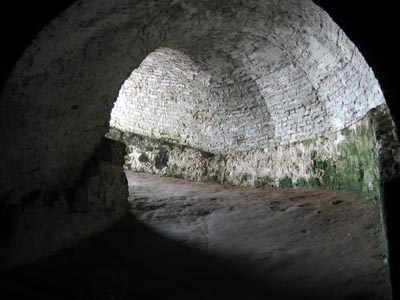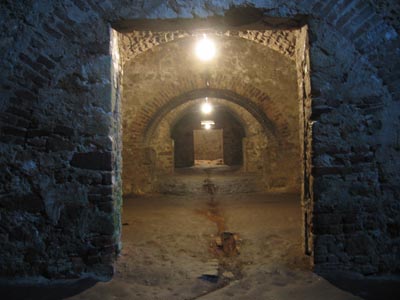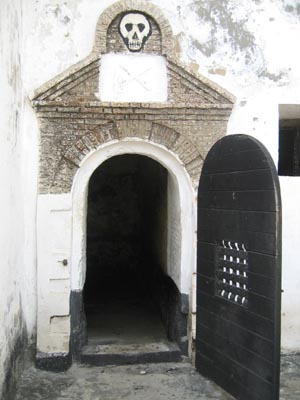Elmina
Elmina a small village in Ghana, located about 15 minutes west of Cape Coast. I visited it the day after visiting Cape Coast and before visiting Hans cottage Botel and Kakum National Rainforest Park. There are three things to explore in Emlina:
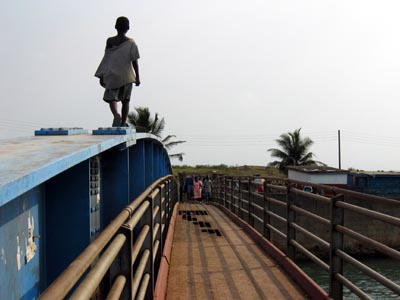
This bridge crosses the river that flown through town. Just to the left of this photo you would find the Slave Castle.
Elmina - The village
Elmina is a quaint little town, not unlike cape coast. It’s just a little smaller and a little dirtier. Other than the castle and the fort, there is a vibrant fishing culture that can be seen along the shore. The boats are very traditional is style and size. They don't use modern fishing techniques, the go out when the tide goes up and use the lowering of the tide to beach their boats. It's quite an interesting site actually, very colourful.
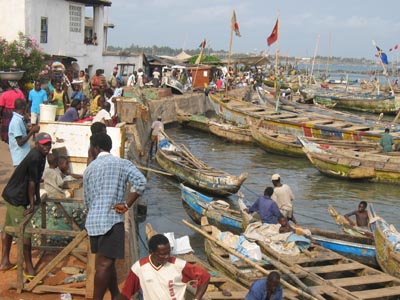
Elmina is a fishing town, bustiling with all kinds of activity on the coast. 75% of the people have jobs that are in some way related to fish.
On the beach kids can be seen playing soccer all day long. Unfortunately, if you watch the beach long enough, you can also see a number of people sneaking off behind the castle to poop.
Outside the castle and the fort is a soccer team. They are a group of boys who needs shin guards, soccer balls, team jerseys and such to play for the regional Ghana soccer team. You can sign an official sheet showing your donation and seeing what other people have donated as well.
This of course, is all a play. It a way for kids to make a few bucks by preying off the sympathizing unwitting tourists you frequent the region.
Note; you can find the most beggars where there are the most tourists, not where there is the most need.
These kids apparently make quite a good living, and use a good chunk of their cash to buy cigarettes and stuff. Of course, they are very friendly when they talk to you. I say I'm from Canada, and they say "oh, Toronto, Ottawa?» All part of their act to make you think that they are your friends. I had to pass by them about 8 times throughout the day, and each pass by revealed something new about them. Usually they would keep on repeating "Timothy Timothy Timothy" and waving at me as I passed, which was exceedingly annoying. One time I saw some of them writing a perverse poem on one of the rocks in front of the castle. I chased them off. Another time one of them who was sitting on the nearby bridge at the time, and who knew that I spoke French, thought he saw me looking at some woman (I wasn't) and he said "Tu aime cette fille? Je peux lui donner a toi..." meaning "you like her? I can get her for you..." Another one of the guys who was particularly familiar with Toronto, and started naming off DJs in the town, asked me if I would like to drugs with them.
The bottom line for you tourists out there is "Don't ever give money to kids (these guys were teenagers, but I would classify their behaviour as kids). It does more to damage their dignity and proper ambition than it does to help."
Anyway, I was reading an exhibit in the castle about the economic plans for Elmina, and it was quite interesting. It said that 70% of the population depends on fish in some form or another for their livelihood, but that with 100 000 visitors to the castle a year, the tourist potential is huge. They listed all of the problems above as barriers, as well as the fact that all of the drinking spots are inside some dark room instead of out on a patio, and a shortfall of restaurants that aren't hotel restaurants. It dawned on my just how important tourism is as a market to the world economy. It is a way that wealth can be more evenly distributed across the globe in an economically mutually beneficial way. Supporting local hotels, tourist spots, artisans, transportation industry, and restaurants helps a community as a whole. Both the tourist village and the tourist benefit from this transfer of funds. Of course, there is also bad/abusive tourism, but I’ll leave that topic on the cutting room floor.
back to top
Elmina - St.George slave castle
Located just 15 minutes away from the Cape Coast castle is the St.George castle of Elmina. While the Cape castle was controlled for most of its history by the British, St.George was first build by the Portuguese, and then attacked and taken over by the Dutch. Thus, there is both Portuguese and Dutch architecture. The Dutch and the English were bitter enemies and trading rivals. One of the main reasons for some of the fortifications on each castle was for protection from the other castle. These two foes lived within eyeshot of one another along the coast.
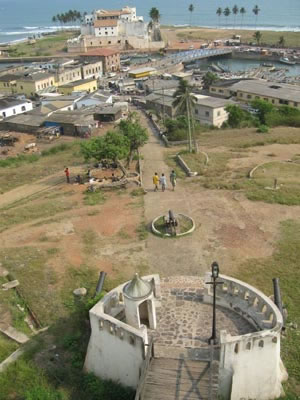
This is a picture taken of Elmina and the castle (at the top of the photo) from the lookout tower of Fort St.Jago.
As far as I understand, the Dutch had taken the castle and the nearby fort initially with the intention to stop the slave trade, and instead focus on Gold and other commodities. Financially however, this proved to be a financial disaster. The Dutch were faced with a decision;
- Resume trading slaves to become profitable.
- Abandon the castle, at which point another country (most likely the British) seize the castle and continue trading slaves.
Of course, they chose number one. It's easy for use to look back in hindsight and righteously say we would have picked number two, that we would take the moral high ground. Consider this though; the St.George castle had two churches, one of which was located directly over the female slave dungeons.
All of a sudden my confidence in my sense of righteousness felt delicately vulnerable.
Architecturally, the castle in Mina is much more impressive than the St.George castle in Cape Coast. There are sweeping archways everywhere, and empty moat, an interesting patrol route along the top rim of the castle, and many confusing passageways.
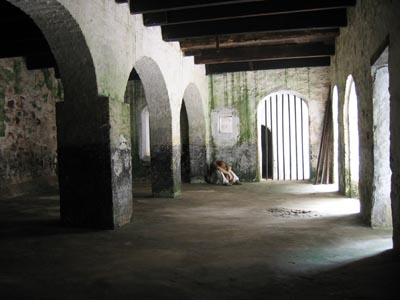
This slave dungeon held 300 women, 150 on each side of the pillars.
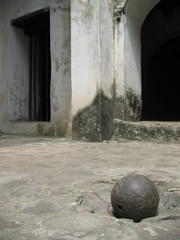
The treatment of the prisoners was pretty much the same as at Cape Coast castle. One new manner of torture that was pointed out was a ball and chain, unmovable on the ground. It was located in the courtyard between all of the female slave dungeons. If a woman misbehaved, she would be chained to this ball and left in the courtyard in the scorching sun. In the meantime, officers were free to rape her and mistreat her as they saw fit. Through the bars of the dungeons the other women would be able to observe what was going on, as an intimidation tactic to deter them from stirring up trouble.
Overlooking this courtyard between all of the female slave dungeons was a platform. The women would be summoned out of their dungeons into the courtyard, and the general of the castle would select from them a woman to enter his sleeping quarters for the night. This woman would be escorted up through a special "trapdoor" leading almost directly to the general's quarters.
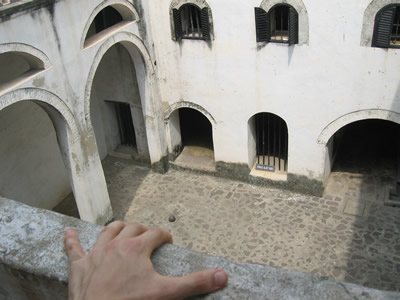

Overlooking the courtyard, the general can see the slave dungeon that is picture in the photo above. He can watch a disobediant slave who is chained to the ball in the court get tortured and raped in the hot sun all day. When it suits him, he calls all of the women out of the dungeons into this courtyard and chooses one to lay with him for the night.
In the thumbnail to the right you can see the decorative symbols directly above the female slave dungeon. It is a church built by the Dutch.
From these relations (as well as impregnated children from rape, and the wives that soldiers took from in the town) came crosses between the white and black people. These children took the names of their European fathers, and for this reason there are today in Ghana many blacks (especially in coastal regions) with European names such as Ferguson, Smith, etc...
A number of emotions come to the surface after seeing these things. The first knee-jerk reaction is to realize what a horrible heritage the Americas and Europe has. One can easily feel very guilty. This feeling is somewhat easily shrugged off though at the realization that I am not my ancestors, I am somebody completely different and unique.
One realization that is somewhat harder to justify is that Most of the prosperity of the Americas and Europe was built upon the slave trade, a basis for which still exists in our society today. The Americas rose quickly to significance and power because we are rich in natural resources, and cheap slave labour was used to harvest that. We were into the state of being a prosperous nation well before the abolition of the slave trade. We had a "running head start" so to speak, a established stable economy, market structures and a diverse set of advanced skills because the labour was left to the slaves, all at the expense of West Africa. We use this still today, and our daily lives today depend on the evils that were done there. The evils can still be felt here in Africa, but we don't notice the results at home because, well, they are positive.
We don't really have much of a choice of our identity' in this matter, and to throw off everything we have for the sake of the moral highroad and a bloodstained heritage would be rather self-defeating. No, a better approach is to realize that in our high place, we are also burdened with more responsibility. It is our role to accept that responsibility.
I watched the Nuremburg trials two weeks back, and what struck me was that a nearly an entire nation was deceived to ravage Europe and torture the Jews, things that they actually though were good. This included even the top generals who were on trial, who claimed that they did not see the results of their actions until the proceedings of the trials were complete. They said that they had been lied to and deceived by Hitler. All of this was for self gain.
Then nearly the entire Americas and Europe thought that what they were doing to the slaves was good in the name of economic and self-prosperity. Even churches existed within the walls of the slave trade castle. That's worse than putting a church in the middle of a Columbian drug field today, proclaiming virtue while performing horror.
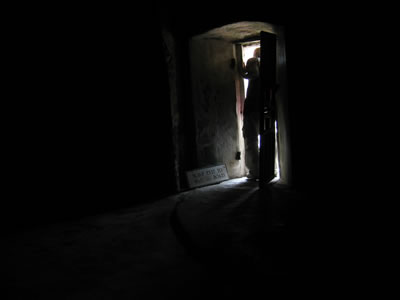
Like the castle at cape coast, Elmina also had it's "Gate of no return". Whereas the cape castle one is large, the Elmina gate is small, just big enough to let somebody of my size through. A person of any sizable girth certainly would not be able to fit. All of the slaves that walked through could fit because they had been so starved for so long.
Again, this makes me feel more vulnerable, that maybe someday I might be ensnared by the same self-righteous trappings. I suppose this is a good realisation, and that an awareness of this weakness makes me stronger.
back to top
Elmina - St.Jago fort
Just about a 7 minute walk up the hill beside Elmina castle is a fort. Its history is similar to that of Elmina castle, originally owned by the Portuguese, then the Dutch, then the English. It served mostly as a military base and lookout point. The top lookout point is quite high and one can easily see all of the village of Elmina and many nearby villages.

This is a 13 photos stitched together to give a panoramic view of Elmina from the lookout tower of St.Jago fort.
Click here or on the picture to see a larger version.
Along with the castles, it has been declared as a world heritage site. Many years back, the fort was actually used as a hotel. Apparently business was very good. Then for some reason it turned to purely a tourist attraction. They wanted to reconvert it into a hotel again, but at that point it was added to the list of world heritage sites and those plans were brought to a halt. At first I though this was a good thing. However, the result is that since all of the hotels are expensive upscale hotels in Elmina, people decide to stay in the nearby cape coast instead for the night. As such they only have time to visit the castle, and skip out on the fort. While the castle get 100 000 visitors a year, I looked at the guest list for the fort and there was only like 10 visitors in the last week. So, many of the rooms are half converted to sleeping chambers, and the electricity to the place was cut because they couldn't pay the bills. It's a pretty nifty little stop though, just not quite as nifty as the castle.

























 The treatment of the prisoners was pretty much the same as at Cape Coast castle. One new manner of torture that was pointed out was a ball and chain, unmovable on the ground. It was located in the courtyard between all of the female slave dungeons. If a woman misbehaved, she would be chained to this ball and left in the courtyard in the scorching sun. In the meantime, officers were free to rape her and mistreat her as they saw fit. Through the bars of the dungeons the other women would be able to observe what was going on, as an intimidation tactic to deter them from stirring up trouble.
The treatment of the prisoners was pretty much the same as at Cape Coast castle. One new manner of torture that was pointed out was a ball and chain, unmovable on the ground. It was located in the courtyard between all of the female slave dungeons. If a woman misbehaved, she would be chained to this ball and left in the courtyard in the scorching sun. In the meantime, officers were free to rape her and mistreat her as they saw fit. Through the bars of the dungeons the other women would be able to observe what was going on, as an intimidation tactic to deter them from stirring up trouble.
 Overlooking the courtyard, the general can see the slave dungeon that is picture in the photo above. He can watch a disobediant slave who is chained to the ball in the court get tortured and raped in the hot sun all day. When it suits him, he calls all of the women out of the dungeons into this courtyard and chooses one to lay with him for the night.
Overlooking the courtyard, the general can see the slave dungeon that is picture in the photo above. He can watch a disobediant slave who is chained to the ball in the court get tortured and raped in the hot sun all day. When it suits him, he calls all of the women out of the dungeons into this courtyard and chooses one to lay with him for the night.
